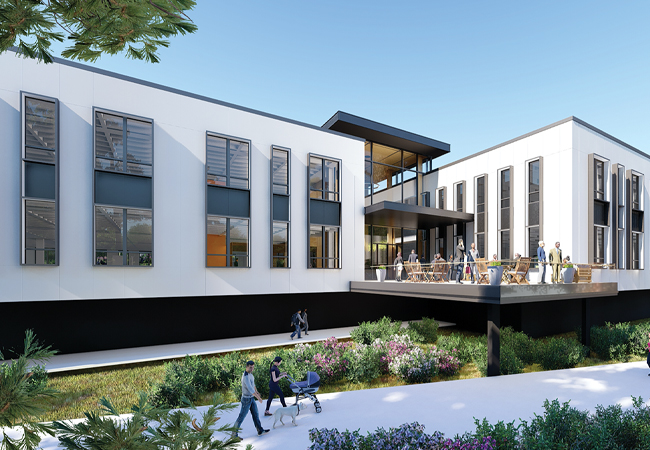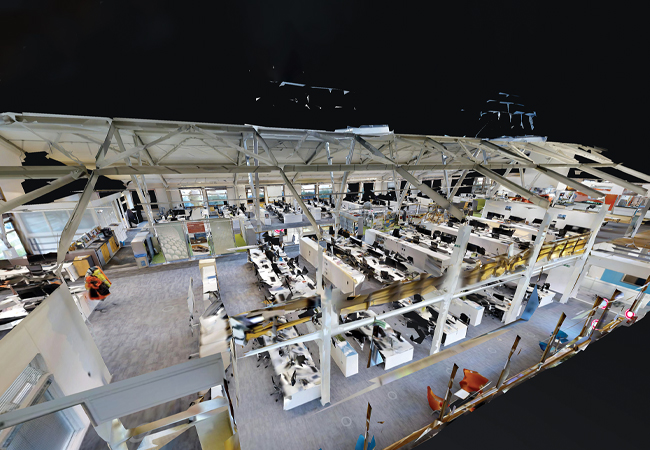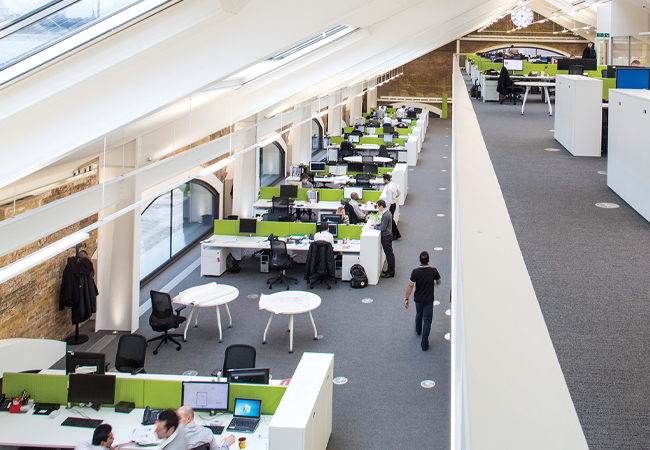
Built environment professionals can learn a lot from post-occupancy evaluation. Asking building users how they feel about space and services can help designers be more conscious of what works well and what does not. Typically, building occupancy satisfaction surveys focus on how physical and environmental conditions affect occupant satisfaction and productivity.
The influence of broader management issues has received less attention by built environment professionals. So, as part of a major workplace satisfaction study at consulting engineers Hoare Lea, an objective was established to understand how organisational factors influence working conditions. This was to complement research on the influence of design and indoor environment quality. The findings show the importance of team engagement and flexible working in the assessment of workplace satisfaction and productivity.
Hoare Lea adapted previous workplace satisfaction survey formats to create a comprehensive questionnaire that covered four categories: impression of the workplace; perception of environmental conditions; the rating of facilities/amenities; and how methods of working are perceived to influence productivity.
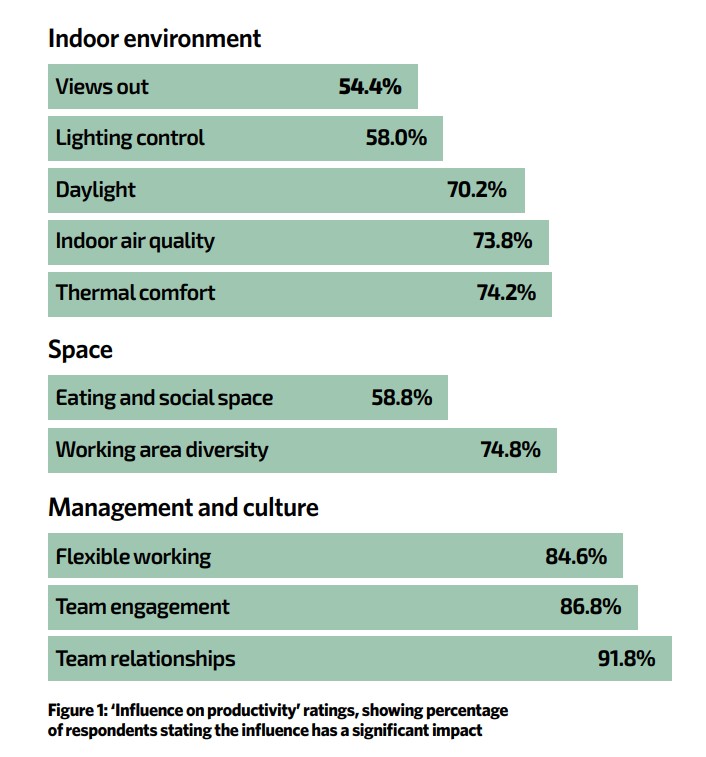
More than 500 responses were received from 12 offices, which gave a large sample of data to analyse. A review of the survey results was supported by Dr Marcella Ucci, senior lecturer at UCL, and Yudi Huang, a student on the health, wellbeing and sustainable buildings MSc.
The survey allowed Hoare Lea to ask employees which factors they perceive as having the most impact on their wellbeing and ability to work effectively, and to rate those factors in their office. Statistical analysis was then conducted to ascertain key relationships within the data.
It tested factors such as the influence of the indoor environment on wellbeing indicators, and investigated correlations between various environmental parameters, such as daylight, and satisfaction with temperature. It also compared perceptions of air quality, against actual measured air quality data.
The survey broadly comprised rating questions, so typically took only seven minutes to complete. Each survey section also included a ‘comments’ section for respondents to give open-ended comments and justifications for their ratings. Parameter ratings data was then used for comparison across office location, work role, demographic information and facilities in each office. We also looked at interrelations between responses, to establish whether answers/ratings for one parameter had a significant influence on another.
The nature of the survey and extent of responses facilitated an extensive dataset for analysis, both internally, and through Hoare Lea’s MSc dissertation partnership with UCL. For Hoare Lea, there were a number of useful messages to take away from the data.
The overall impression of the workplace is largely influenced by three factors: layout; how well it portrays the firm’s image; and how well the space is used. Other factors, such as quality of decoration and tidiness, have a secondary influence. The perception of indoor environmental quality is most strongly influenced by thermal comfort in summer and how well comfort is controlled in general. Secondary environmental influences are comfort in winter and indoor air quality.
Self-reported perceptions of health and wellbeing showed strong correlation with satisfaction with other aspects of the office, and overall enjoyment at the workplace. This could suggest that a high-quality physical working environment (good thermal comfort, daylight, air quality, and so on) could contribute positively to a sense of health and wellbeing among workplace occupants.
Feedback comments on health and wellbeing show the value of an office having good amenities, daylight and acoustic conditions, and green plants. People that rate the ‘health and wellbeing’ characteristics highly are also likely to say they enjoy working at the office.
Whether an office was naturally or mechanically ventilated had little influence on whether occupants were satisfied with the indoor air quality. The air-change rates and density of occupants have more significance than the means of ventilation.
There was no great difference in perceptions of indoor environmental quality for men and women. There was some difference across age groups, however; perceptions of influences on productivity diminished with seniority. Younger people across the firm perceived environmental, spatial and cultural factors to have more influence on their productivity than their older peers. So a manager has to be aware that workstyle and environmental conditions may have more impact on productivity than they realise from their own experience.
Statistical analysis conducted by UCL’s research student indicated there was a forgiveness effect among occupant responses. That is, overall ratings for a category were generally higher than the average rating of the constituent elements of that category. For example, a respondent may have rated general comfort conditions as very good while their ratings of individual indoor environmental quality parameters do not add up to this overall score. This suggests that while an office occupant may have a gripe or issue about a parameter, they ‘forgive’ that when they rate it in combination with other parameters and provide a better overall category rating.
The greatest ‘forgiveness’ effect or tolerance of a category was shown to be people’s overall impression of the workplace. So, if the office layout, image and use of space is good, occupants will be more tolerant of, for example, maintenance.
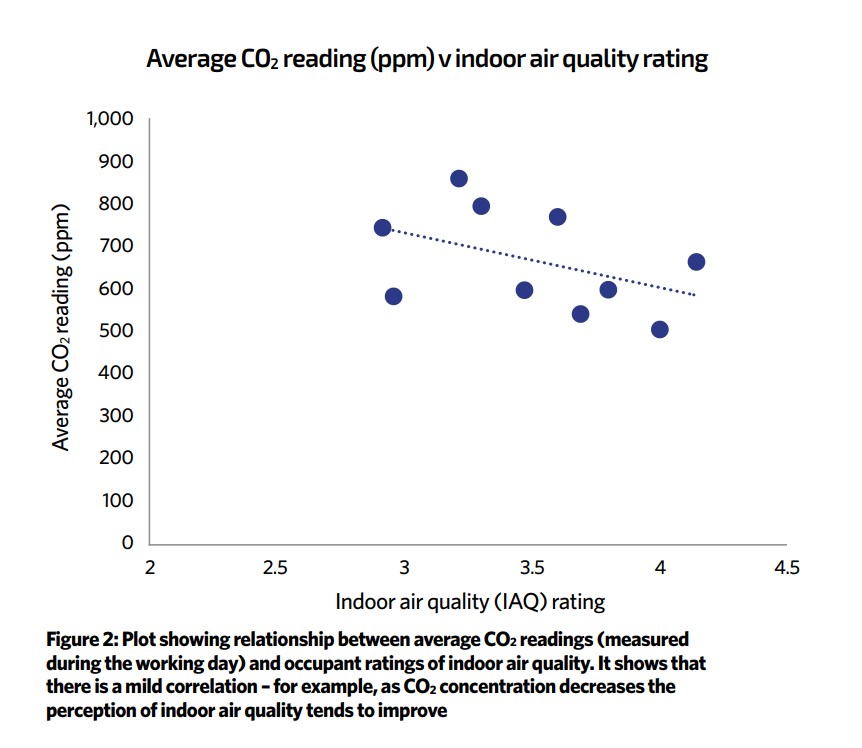
Effective control of comfort was found to be an influential factor in overall satisfaction and perception of health and wellbeing in the workplace and enjoyment at work. So, designers and facilities managers must be mindful that occupants are given appropriate environmental conditions and that these are well controlled and maintained. This need not entail providing individual control.
When rating office facilities, the most influential factors were kitchen, toilets, variety of working areas, and availability of meeting rooms. The number of desks, breakout spaces, and impression of the reception had a secondary influence. This shows that it’s more important for designers to consider the range and quality of workplace needs than the provision of individual desks. Indeed, with agile working and hot desking, these priorities will increasingly influence workplace satisfaction.
A specific objective of the survey was to clarify how employees rate a range of parameters influencing the ability to work effectively – for example, productivity. Overall, perceptions of factors influencing productivity show that cultural and organisational elements – for example, levels of team engagement, team relationships, and the ability to work flexibly – are more impactful than physical environmental factors. Of the physical environmental factors rated, ‘thermal comfort and temperature control’, and ‘indoor air quality’ were perceived to be most influential on productivity (Figure 1).
Finally, we compared perceptions of indoor air quality in each office with actual measured air quality. We had access to data using Wi-Fi air-quality sensors that measure concentrations of CO2, among other things. We wanted to find out if occupant perceptions are good or bad indicators of actual air quality – and there is a positive correlation, albeit mild (Figure 2). In other words, if staff feel the air quality is good, it probably is, but measurement of CO2 concentrations can highlight whether the ventilation rate is adequate or other factors are at play.
In a separate study by Hoare Lea for a client, complaints of stuffiness highlighted insufficient ventilation rates arising from a defective system. In another office with complaints of stuffiness, it was found that office densities and organisational factors played an important role
Key lessons
There are some useful summary insights to be gained from this workplace satisfaction survey.
- Designers and building managers should appreciate the range of physical factors influencing workplace satisfaction and wellbeing. Good overall design, that makes effective use of the space while providing a variety of working areas, are crucial in the modern office.
- Managing thermal comfort, air quality, daylight and acoustic conditions are important environmental considerations, but controlling these effectively has an influence on wellbeing. Climate change, and the predicted increase in frequency of heatwaves, would indicate that limiting overheating in the workplace should be a particular focus for designers and building managers.
- Younger employees are more aware of, or sensitive to, indoor environmental conditions and the quality of facilities – perhaps because they spend more time in the office than their older colleagues. It’s important therefore, that designers and building managers engage with those most impacted by the environmental conditions when planning workplace modifications and refurbishments.
- Simple measures – such as installing air-quality sensors to check the adequacy of ventilation rates; giving clarity on how comfort should be controlled; improving maintenance response times; and providing plants in the workplace – can improve occupant satisfaction and wellbeing.
Ashley Bateson is a partner at Hoare Lea, Chris Pottage is an associate at Hoare Lea, and Marcella Ucci is a senior lecturer at UCL

